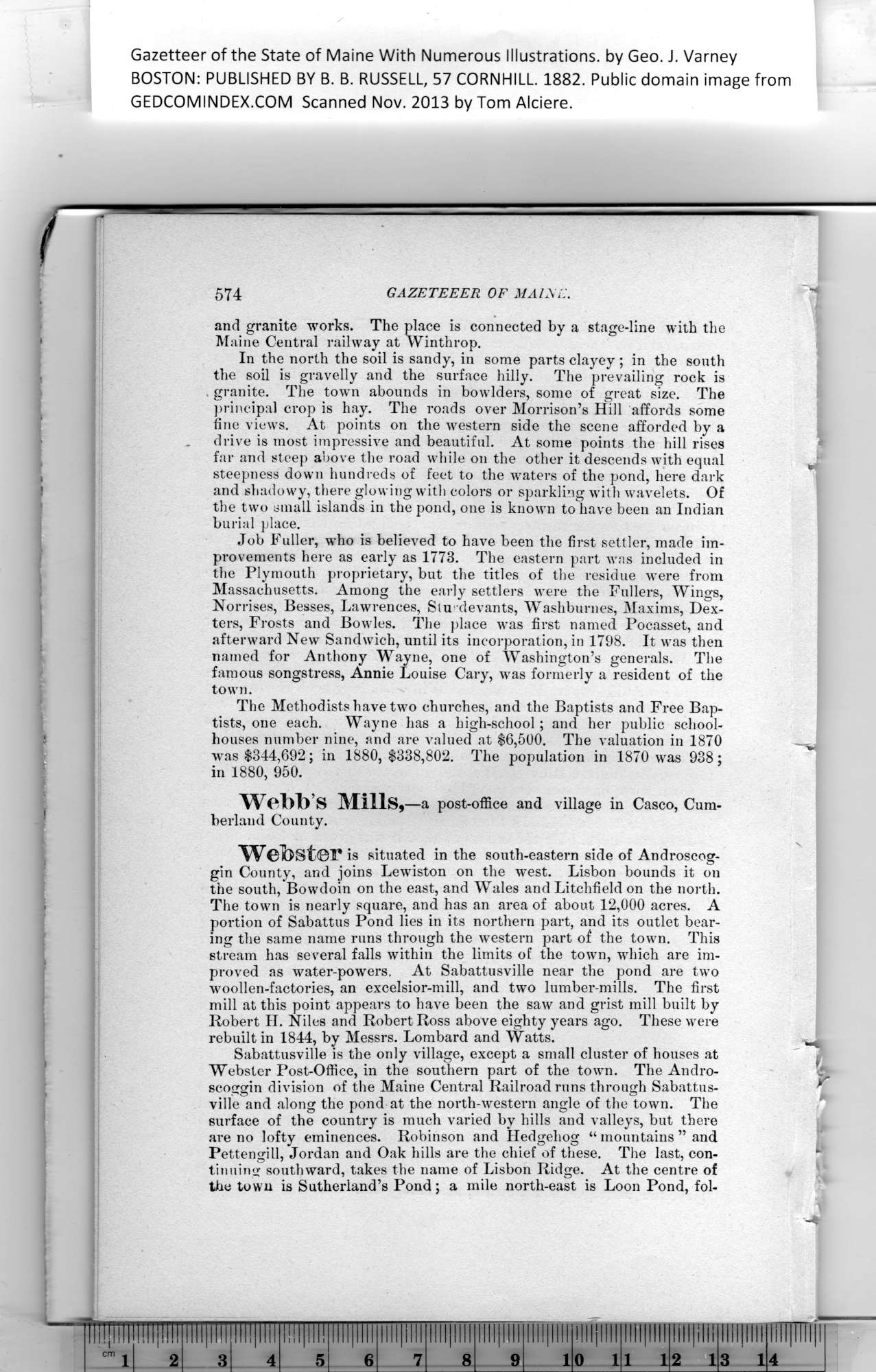|
Gazetteer of the State of Maine With Numerous Illustrations, by Geo. J. Varney
BOSTON: PUBLISHED BY B. B. RUSSELL, 57 CORNHILL. 1882. Public domain image from
574 GAZETEEER OF MAINE.
and granite works. The place is connected by a stage-line with the
Maine Central railway at Winthrop.
In the north the soil is sandy, in some parts clayey ; in the south
the soil is gravelly and the surface hilly. The prevailing rock is
granite. The town abounds in bowlders, some of great size. The
principal crop is hay. The roads over Morrison’s Hill affords some
fine views. At points on the western side the scene afforded by a
drive is most impressive and beautiful. At some points the hill rises
far and steep above the road while on the other it descends with equal
steepness down hundreds of feet to the waters of the pond, here dark
and shadowy, there glowing with colors or sparkling with wavelets. Of
the two small islands in the pond, one is known to have been an Indian
burial place.
Job Fuller, who is believed to have been the first settler, made im-
provements here as early as 1773. The eastern part was included in
the Plymouth proprietary, but the titles of the residue were from
Massachusetts. Among the early settlers were the Fullers, Wings,
Norrises, Besses, Lawrences, Stu-devants, Washburnes, Maxims, Dex-
ters, Frosts and Bowles. The place was first named Pocasset, and
afterward New Sandwich, until its incorporation, in 1798. It was then
named for Anthony Wayne, one of Washington’s generals. The
famous songstress, Annie Louise Cary, was formerly a resident of the
town.
The Methodists have two churches, and the Baptists and Free Bap-
tists, one each. Wayne has a high-school; and her public school-
houses number nine, and are valued at $6,500. The valuation in 1870
was $344,692; in 1880, $338,802. The ponulation in 1870 was 938;
in 1880, 950.
Webb’s Mills,—a post-office and village in Casco, Cum-
berland County.
Webst©r is situated in the south-eastern side of Androscog-
gin County, and joins Lewiston on the west. Lisbon bounds it on
the south, Bowdoin on the east, and Wales and Litchfield on the north.
The town is nearly square, and has an area of about 12,000 acres. A
portion of Sabattus Pond lies in its northern part, and its outlet bear-
ing the same name runs through the western part of the town. This
stream has several falls within the limits of the town, which are im-
proved as water-powers. At Sabattusville near the pond are two
woollen-factories, an excelsior-mill, and two lumber-mills. The first
mill at this point appears to have been the saw and grist mill built by
Robert H. Niles and Robert Ross above eighty years ago. These were
rebuilt in 1844, by Messrs. Lombard and Watts.
Sabattusville is the only village, except a small cluster of houses at
Webster Post-Office, in tbe southern part of the town. The Andro-
scoggin division of the Maine Central Railroad runs through Sabattus-
ville and along the pond at the north-western angle of the town. The
surface of the country is much varied by hills and valleys, but there
are no lofty eminences. Robinson and Hedgehog “ mountains ” and
Pettengill, Jordan and Oak hills are the chief of these. The last, con-
tinuing southward, takes the name of Lisbon Ridge. At the centre of
the town is Sutherland’s Pond; a mile north-east is Loon Pond, fol-
PREVIOUS PAGE ... NEXT PAGE
This page was written in HTML using a program written in Python 3.2
|
